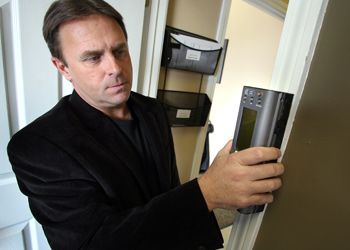Getting the lead out | New EPA regs send contractors scrambling for training
With barely a week to spare, Micah Holloway breathed a sigh of relief when his company successfully met the April 22 deadline to become certified under new federal lead abatement rules.
Holloway, owner of Holloway Construction Inc. in Portland, says his lead supervisor took the federal agency’s eight-hour course in April and now will train him and the company’s one other employee.
Holloway still has to spend a few thousand dollars to buy equipment to meet the new U.S. Environmental Protection Agency standards for working on homes built before 1978 — the latest attempt by government to rid the nation of toxic lead-based paint used widely until it was banned in 1977. In Maine, which has some of the oldest housing stock in the country, the new regulations have prompted a rush for certification by home remodelers, painters and other construction professionals who face fines of $37,500 per day if they’re found in noncompliance.
But the timeline for implementing the new rules, coupled with an industry that is already suffering from high unemployment and scant work, has some people forecasting serious repercussions. According to the Maine Department of Labor, the number of unemployed construction workers increased by more than 105% from 2008 to 2009, from 1,439 to nearly 3,000.
“It’s going to be a hard law for a lot of people to follow,” says Holloway, whose company specializes in new construction, additions, custom kitchens and baths and general contracting. “I would probably say that it is definitely overkill.”
New rules for old buildings
Under the new EPA requirements announced in October, painters, electricians, plumbers and contractors who renovate or remodel homes, schools or day care centers built before 1978 must be certified. The rules do not apply to one-bedroom dwellings, such as college dorm rooms or elderly care facilities. Contractors cannot work on an interior space larger than 6 square feet or an exterior space of 20 square feet without an EPA certification.
Certification costs $195 for an eight-hour class to learn how to prevent lead contamination, in addition to a $300 EPA registration fee. Contractors must also purchase more than $2,000 in equipment, such as a commercial HEPA vacuum and filters, qualified plastic sheeting and other supplies. If they do not follow the mandated practices at a job site, they can be fined as much as $37,500 per violation per day.
Luckily for Holloway, he has enough work already in progress to pay the costs of the new equipment and certification. But others aren’t so lucky.
Nancy Barmakian, manager of the EPA’s toxics and pesticides technical unit, said 1,000 renovators in Maine have been certified since trainings began in October. But according to Mark Coleman, president of BioSafe Environmental in Westbrook, which teaches the certification classes, that’s a small fraction of the thousands who still need it.
“Our phones have been ringing off the hook,” says Coleman. His company is accepting registrations through August, an unofficial extended deadline given by the EPA. Coleman says as long as a contractor submitted an application to enroll in a certification class before the April deadline, EPA inspectors will not fine them at their job sites.
He estimates Maine has approximately 32,000 people who work as painters, plumbers, electricians and construction workers and speculates it will take a long time to get them all certified. Gary Jordan, president of the Home Builders and Remodelers Association of Maine in Augusta, believes certifying those workers this year could be the state’s greatest challenge.
Jordan’s group is holding a training session for at least 30 of the association’s 273 members at the Holiday Inn West in Portland on June 2. But there has been a dearth of trainers to handle the number of contractors who need the class. According to James Bryson, an EPA renovation, repair and painting coordinator, as of early April, there were 22 certified trainers in the EPA’s Region One, which includes the six New England states, and 10 more in the training pipeline.
More than 200 Maine contractors attended an EPA forum on the new rules in March at the Holiday Inn by the Bay. The forum was convened at the request of U.S. Sen. Olympia Snowe, whose office was inundated with calls from contractors concerned about the rules’ impact.
Many, such as Tim Fournier, a design builder who does architectural renovation in Livermore Falls, say compliance will be expensive and could force handymen and smaller contractors out of business. Others complained of the lack of outreach from the EPA and the inadequate supply of trainers.
“Builders in our area don’t know about the rules and if they want to get certified, there is nowhere to go for them,” said Roger Timmons, director of code enforcement for the town of Windham.
When Bryson of the EPA asked contractors at the forum to raise their hands if they could not find a certification class in their area, several hands went up. Maine has just three certified trainers who can teach the required classes, says Bryson.
The classes cover extensive new procedures to document work at job sites that fall within the scope of the regulations. Contractors must close all windows or doors in a work area; seal off ducts and vents; wipe all surfaces with a damp cloth and use a verification card to make sure those areas are completely free of lead. Bryson says he recommends contractors hold onto documents from each job for at least three years.
Jordan of the homebuilders association says the rules are important to protect the health and safety of workers, as well as the people who will live and work in the renovated space. Maine has the highest concentration of pre-World War II housing in the nation.
According to the Maine Bureau of Remediation and Waste Management, hundreds of Maine children are discovered to have elevated lead levels in their blood every year, a condition that can lead to learning disabilities and behavioral problems. It estimates up to 60% of Maine’s housing might contain lead.
“This kind of law really puts a pause in what home builders are doing,” says Jordan. “I personally think it is a very good law, very important.”
Coleman of BioSafe Environmental acknowledges the regulations present a challenge for struggling contractors, but says Maine must do its part to contain lead exposure.
“It’s a big burden on businesses and it’s a big burden on consumers,” he says. “The safety of children should always be at the forefront regardless if we are in recessionary times or boom times.”
Lead abatement certification classes
Contractors who need to become EPA-certified in lead abatement should contact the Maine Department of Environmental Protection’s Bureau of Remediation and Waste Management in Augusta at 287-2651.
To view a training schedule, visit www.maine.gov/dep/rwm/lead/
Bob Cook, Mainebiz staff reporter, can be reached at bcook@mainebiz.biz.











Comments